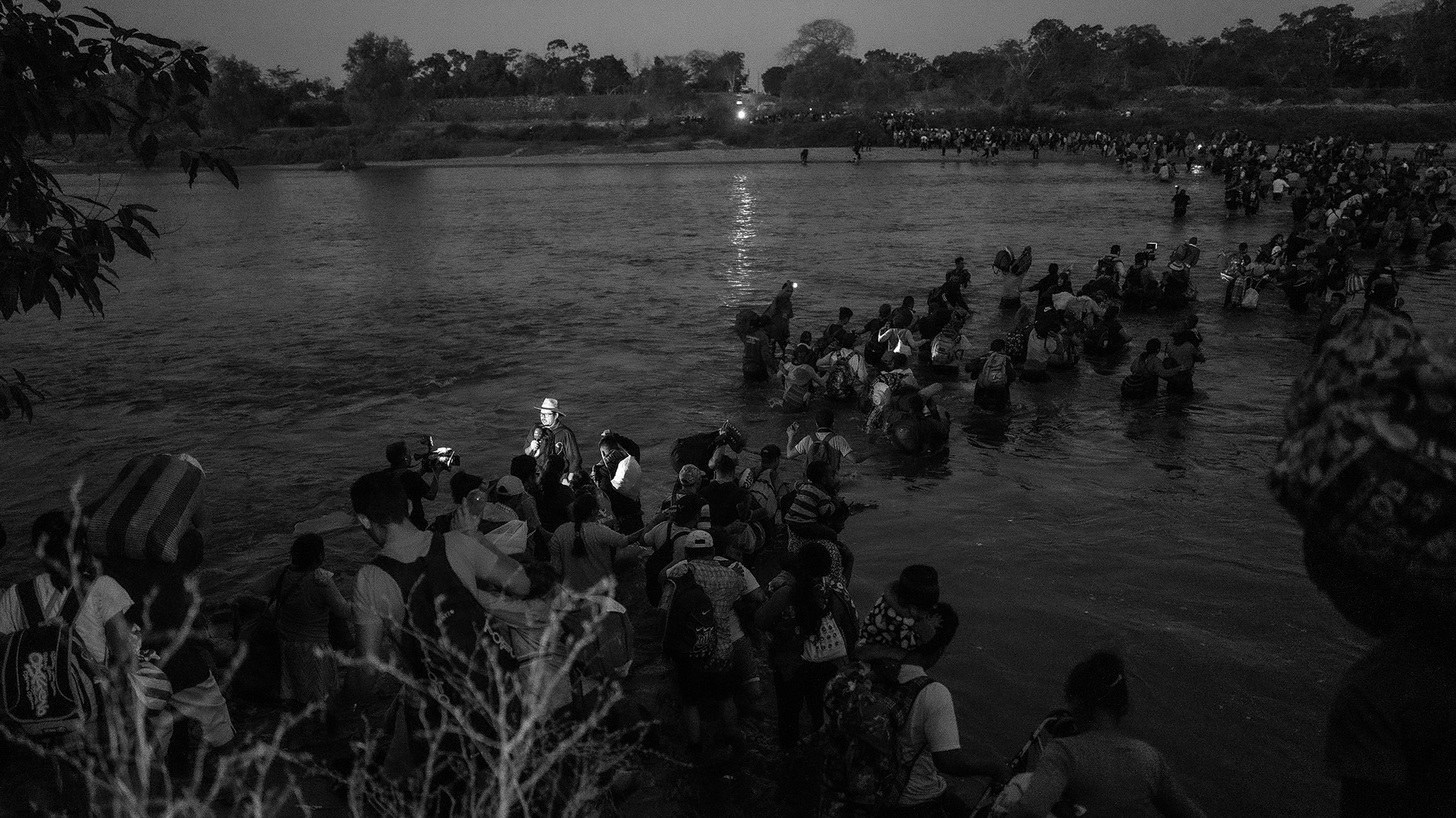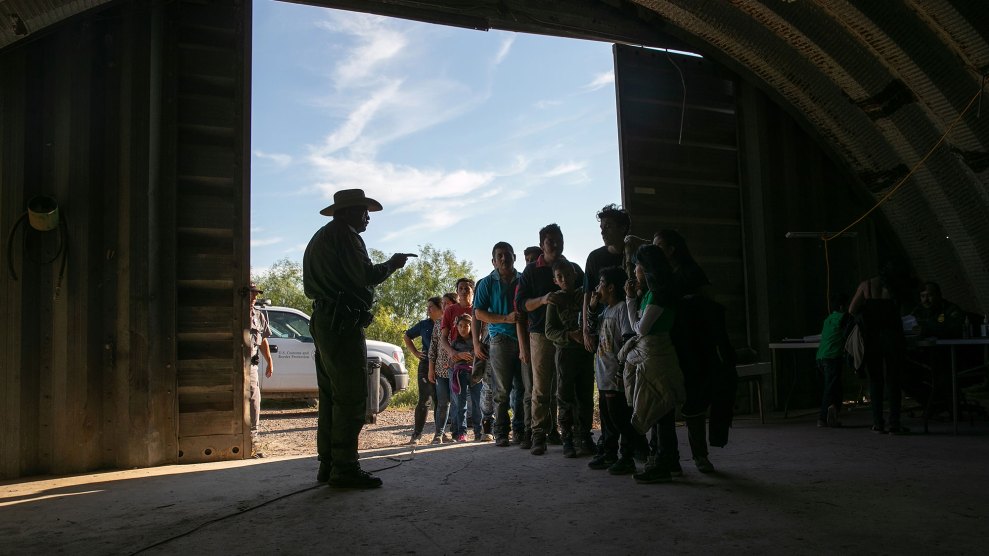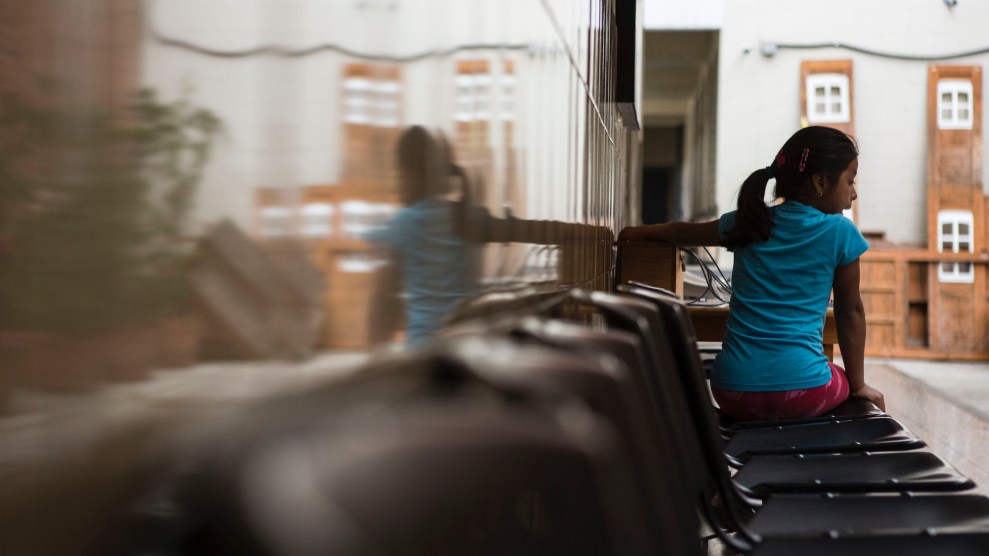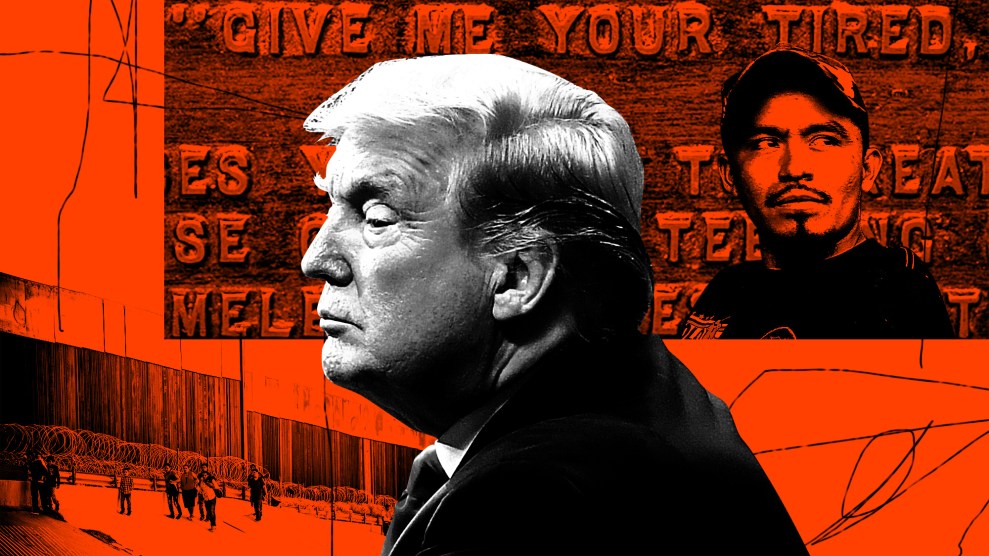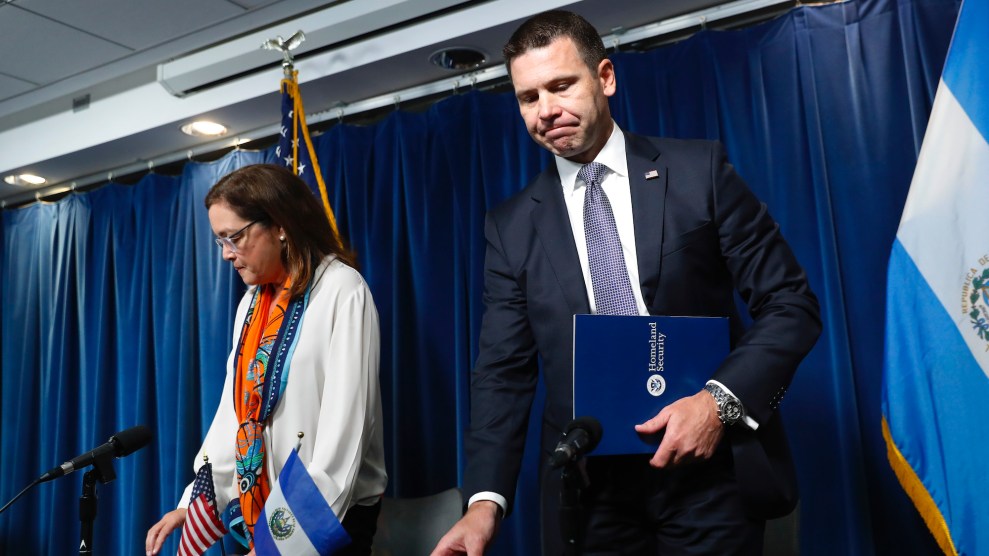Editors’ note: This article appears in both English and Spanish because we wanted to share it with the broadest possible audience, including the communities most directly affected. We’d love to get your feedback about this effort—including whether we should do more of this in the future. Please write us at ian@motherjones.com to let us know what you think.
You need a story. That’s what they say, anyway. You need sympathetic characters, a villain, some violence, maybe a dramatic escape. That’s what it takes to gain asylum in the United States. You need lots of other things, too—a principled Border Patrol agent, a competent asylum officer, a good lawyer, a fair-minded judge—but before any of that you need a story, something that can be fitted into the rapidly narrowing margin of American benevolence. You need a man, say, draping his arm around your shoulder, telling you, “We are watching you.”
That’s where the story of Gaspar Cobo Corio and Francisco Chávez Raymundo might begin. “We are watching you,” the man said out of nowhere. “You didn’t even notice that I have been following you. This was not just today. I have always been following you.”
It was not the first time that Gaspar had been threatened, but this time—right after a town hall meeting he’d organized with Francisco, also a Mayan human rights activist—was different from the harassing phone calls, the angry texts, the break-ins, and even the stickups the two had endured ever since they’d started challenging Guatemala’s culture of official impunity.
For more articles read aloud: download the Audm iPhone app.
Related Stories
America’s Immigration System Was Already Broken. Trump Made a Weapon Out of Its Shards.An Explosive Government Report Exposed Family Separations and Other Immigration Horrors—in 1931Trump Killed My American Dream: 8 Stories From the War on ImmigrantsWhy a Second Trump Term Would Be Even Worse for Immigrants
For years, the two friends had been helping their fellow Ixil Maya testify against General Efraín Ríos Montt, the former president who in 2013 was hauled into court on genocide charges for his role as the architect of the bloodiest campaigns of the country’s 36-year civil war. Since Ríos Montt still had many powerful supporters in the military and the government, joining the case against him was a dangerous proposition. Gaspar and Francisco spent time assisting would-be witnesses with whatever they needed—lodging, food, safe passage to the courthouse—so that the darkest moments of the war could reach the light of day.
There are plenty of Guatemalans who still deny there was a genocide. This casual erasure is so common that one of the municipal candidates participating in Gaspar and Francisco’s town hall had been saying it for months: No hubo genocidio. So that night they pressed him on it—after all, it wasn’t some abstraction for the many Ixil Maya who had lost family members.
The man who followed Gaspar after the event, presumably an ally of the candidate, was not happy about this. “We have warned you many times,” he said. “I am going to be clear with you that this is your last chance.” He told Gaspar that they knew where his family and friends lived, and that they were monitoring them at all times. Gaspar, realizing that he’d never seen this man before in his life, asked him why he was doing this.
The man pulled Gaspar’s left hand toward his waistband. He felt cold metal. “Thank you for the warning,” Gaspar told the man. Moments later, he found himself alone. He contacted Francisco with the news of what had just happened. They realized they’d just become characters in a storyline they wanted no part of, and so, after laying low for the better part of a week, they did what they knew they needed to do. They found a coyote, said goodbye to their families, and got the hell out of Guatemala.
Gaspar and Francisco’s account checks all the boxes of a successful asylum claim. They belong to an indigenous group that was targeted in a civil war, were threatened with death for their work as human rights activists, and have a well-founded fear of being persecuted if they return home. But when they fled and headed north in June 2019, it was in the midst of the Trump administration’s unprecedented attack on the American asylum system. For months, the southwest border had been a no-go zone for asylum seekers: First, Border Patrol agents limited the number of claims they’d process in a given day; then, they started sending asylum seekers back to Mexico to wait out their day in court; when that wasn’t enough, the administration put into effect an asylum ban that gave immigrants a vanishing chance of protection at the southern border; and then, after all that, they even started deporting them to Guatemala and El Salvador and Honduras to seek asylum in the very countries many of them were escaping. As Gaspar and Francisco bided their time in Ciudad Juárez, just south of El Paso, COVID-19 came and provided Donald Trump and Stephen Miller the opportunity they’d been waiting for to close the border for good, to everyone and anyone arriving for almost any reason.
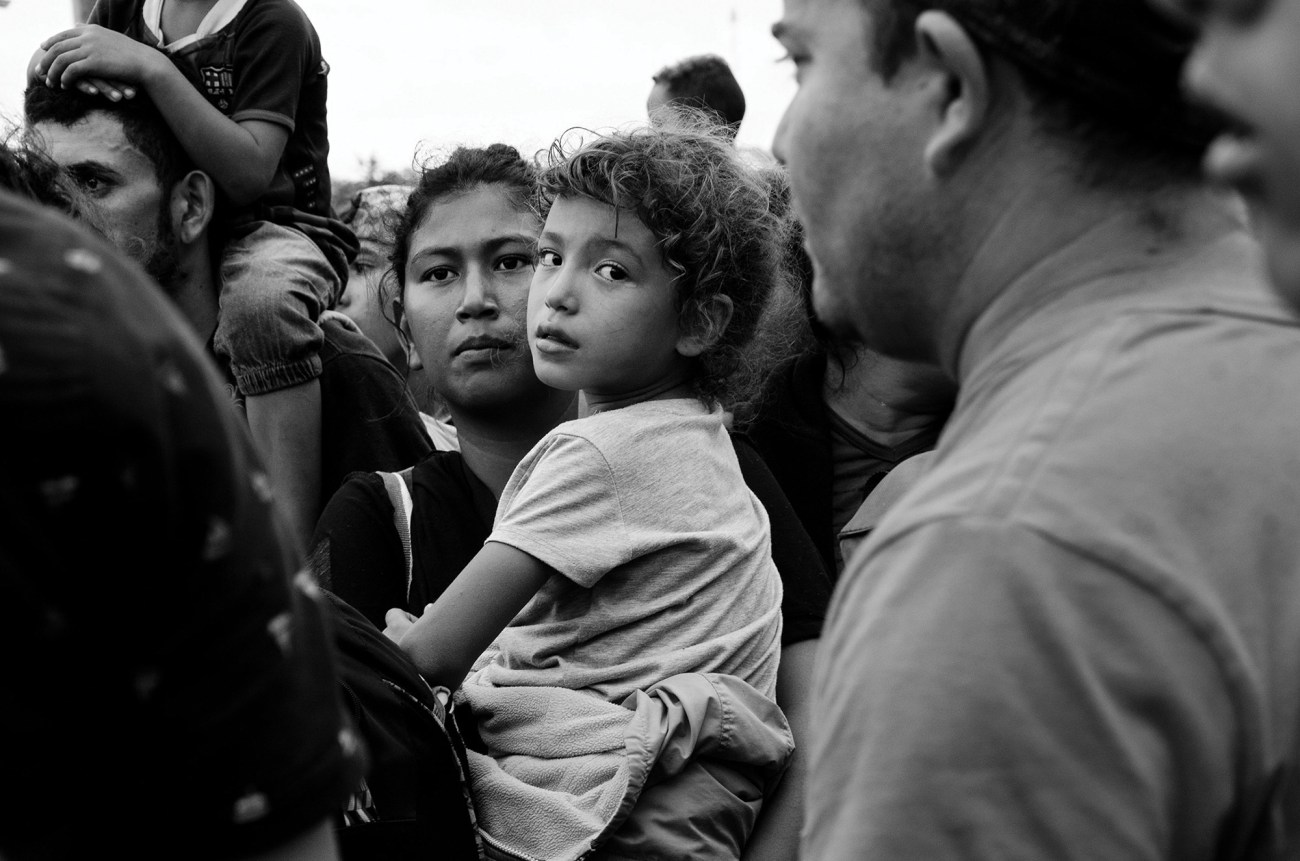
Photographer Ada Trillo has documented the caravans of asylum seekers on their way to the United States, most recently for her project La Caravana del Diablo. Above, Chelita clings to her mother as they wait to be admitted into Mexico.
The president had previewed this shutdown long before the coronavirus arrived in the United States. In April 2019, he inveighed against an asylum system that he blamed for a massive increase in the number of migrants arriving at the southern border. At an event at the Border Patrol station in Calexico, California, on April 5, Trump grumbled, “It’s a colossal surge and it’s overwhelming our immigration system, and we can’t let that happen. So, as I say, and this is our new statement: The system is full. Can’t take you anymore. Whether it’s asylum, whether it’s anything you want, it’s illegal immigration. We can’t take you anymore. We can’t take you. Our country is full…Can’t take you anymore, I’m sorry. Can’t happen. So turn around. That’s the way it is.”
His blunt delivery in Calexico morphed into a grotesque shtick a day later in Las Vegas, where he addressed the Republican Jewish Coalition at megadonor Sheldon Adelson’s Venetian casino. “The asylum program is a scam,” Trump said. “Some of the roughest people you’ve ever seen—people that look like they should be fighting for the UFC. They read a little page given by lawyers that are all over the place—you know, lawyers. They tell them what to say. You look at this guy and say, ‘Wow, that’s a tough cookie!’” He paused, gesturing like he was reading from a statement and launching into his best big-galoot voice. “‘I…am…very…fearful for my life. I am very worried that I will be accosted if I am sent back home.’” He stopped to raise his right index finger. “No, no: He’ll do the accosting.” The crowd laughed, ate it up. “Asylum”—and here he tried out a whiny, bleeding-heart voice—“‘Oh, give him asylum! He’s afraid! He’s afraid! We don’t love the fact that he has tattoos on his face. That’s not a good sign. We don’t love the fact that he’s carrying the flag of Honduras or Guatemala or El Salvador, only to say he’s petrified to be in his country.’” He stopped again, one more time, and held his arms out wide. “To confront this border crisis, I declared a national emergency.”
In back-to-back appearances, Trump had laid out his administration’s stance toward the hundreds of thousands of people, mostly from the so-called Northern Triangle of Central America, who had showed up to the border over the past several years in search of asylum. They were con artists, thugs, and cheats, and besides, there wasn’t any room left at the inn. Tough shit.
That the United States has long-standing commitments to asylum seekers under federal law and international agreements is of little consequence to Trump and his coterie of immigration hardliners. Even less compelling to the White House is the role asylum plays in the aspirational story of America that we have been telling the world for decades: that, in a country of immigrants, ensuring the safety of those fleeing repression and violence is our duty, and by welcoming them—by doing the right thing—the United States both fulfills its promise and distinguishes itself from all other nations.
Democrats have invoked this line of thinking in criticizing Trump’s policies as coldhearted and un-American. Rep. Alexandria Ocasio-Cortez called the situation at the border “a policy of dehumanizing.” House Speaker Nancy Pelosi said it was “a clear abdication of American humanitarianism.” Oregon Sen. Jeff Merkley, whose viral videos from the borderlands helped bring family separation into full view in 2018, titled his 2019 book America Is Better Than This: Trump’s War Against Migrant Families. “President Trump has taken America to a dark place,” he writes. “A place deeply rooted in racism. A place deeply connected to a political strategy based on dividing America into groups and pitting one group against another. This is doing great damage to our national soul. And we need to end it.”

Joel crosses the Suchiate River between Guatemala and Mexico.
Joe Biden has a 22-page plan to do just that—“The Biden Plan for Securing Our Values as a Nation of Immigrants.” In it, he not only proposes rolling back Trump’s executive actions on immigration and asylum but continues far to the left of Obama-era policies. To address the root causes driving people out of Central America, he’d spend $4 billion to attack corruption and strengthen civil society in the region. He also proposes working with Congress to create a path to citizenship for the nearly 11 million undocumented immigrants living in the United States. “We’re going to restore our moral standing in the world and our historic role as a safe haven for refugees and asylum seekers,” Biden promised at the Democratic convention.
Yet embedded in this belief in our better angels is the assumption that the Trump era is an aberration—not the logical extension of policies that have been in place for decades. The process for dealing with asylum seekers and refugees has always been fraught, shot through with xenophobia and racism and the callous geopolitical reasoning of who, exactly, is worthy of protection from persecution. As it has on so many issues, the Trump administration exploited the arbitrariness and fragility of this system, making a difficult situation completely perilous—particularly for the tens of thousands of people from the Central American countries whose US-sponsored wars provoked an asylum emergency 40 years ago.
The situations those asylum seekers are fleeing have changed dramatically over time. Death squads have been replaced by street gangs. But when they arrive in the United States, they’re still carrying personal narratives of unthinkable violence and victimization. To have the slightest chance of staying, argues Brooklyn Law School professor Stacy Caplow, they must above all establish credibility with asylum officers and immigration judges by providing facts about their lives that are “detailed, plausible, and consistent.” An account like Gaspar’s, repeated, time and again, in a similar order and fashion. “The system wants to see not only fear, but narrative,” journalist John Washington writes in his essential new book, The Dispossessed.
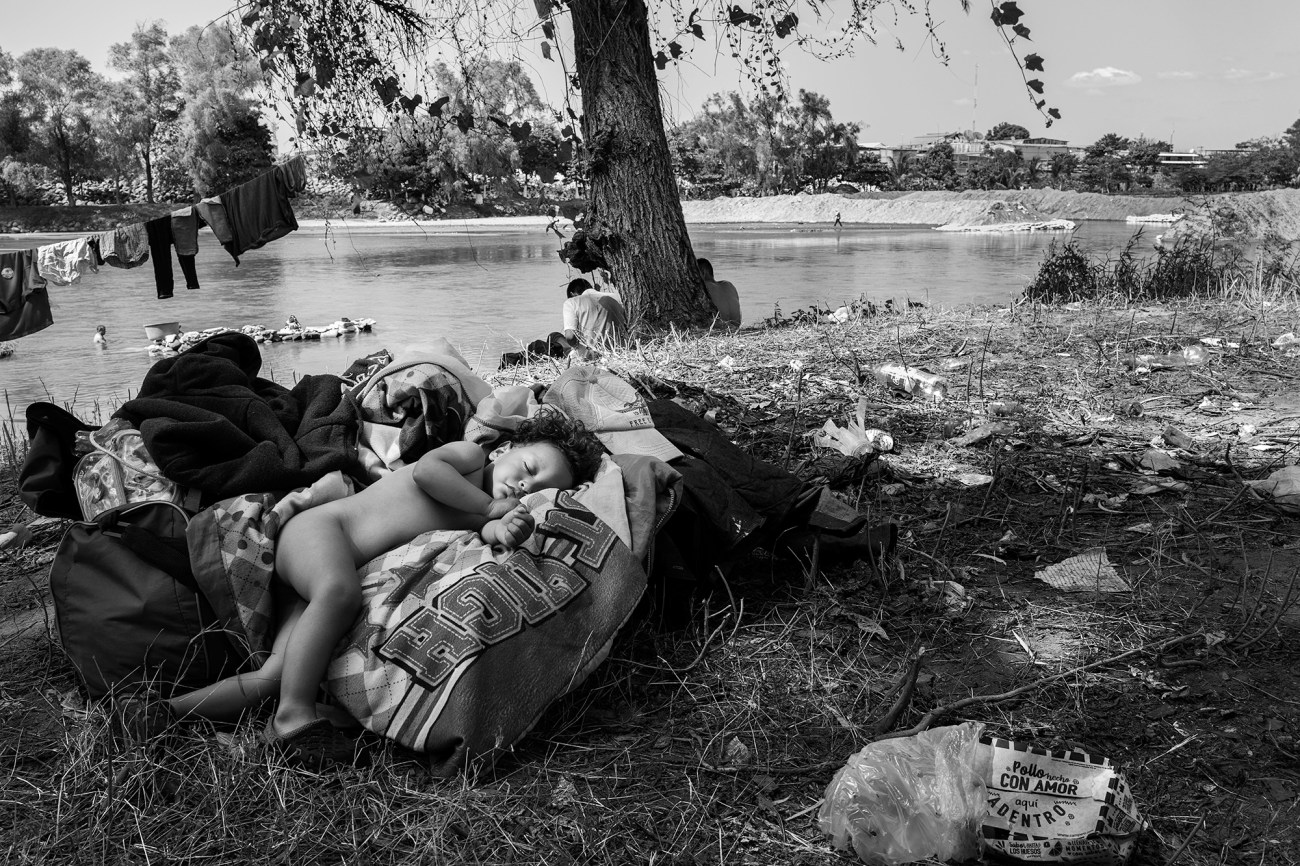
A child traveling with the caravan sleeps by the Suchiate River.
The system may have once wanted these kinds of facts, even if only to pay lip service to the idea of an impartial and independent process, and a just and compassionate nation. But in sealing off the country completely, the Trump administration has told the world that it wants everyone else to just shut the hell up and leave it alone. Our country is full. Come November, we’ll find out if that’s the story Americans want to keep telling.
When I spoke with Carlos Spector, the El Paso lawyer representing Gaspar and Francisco, I asked him to explain how asylum law works—as if I were a stranger bellied up next to him at his favorite bar. What would he say? He laughed. “Well, depends on how drunk I was.”
Imagining that the pandemic was over, his local watering hole was open once again, and he had a pleasant buzz, Spector launched into his barroom soliloquy. “Let me tell you what it’s all about,” he said. “Once upon a time, there was an evil man named Hitler.”
World War II is a popular starting point in explaining asylum law. The first modern effort to prevent people from seeking shelter from persecution came when Western democracies, including the United States, tried to contain European Jews fleeing the Nazis. Although 127,000 Jewish refugees were admitted to the United States between 1933 and 1940, most applicants were rejected, even though the rarely filled immigration quota for Germans would have allowed an additional 110,000 people. Washington writes that not only did US officials keep Jews out because of their supposed likelihood to become public charges (some real Stephen Miller vibes there) but also that Franklin D. Roosevelt’s refugee policy adviser happened to be “an avowed racist and eugenicist” (okay, there too). In January 1939, two-thirds of Americans said they opposed a bill that would have admitted 20,000 German Jewish children.
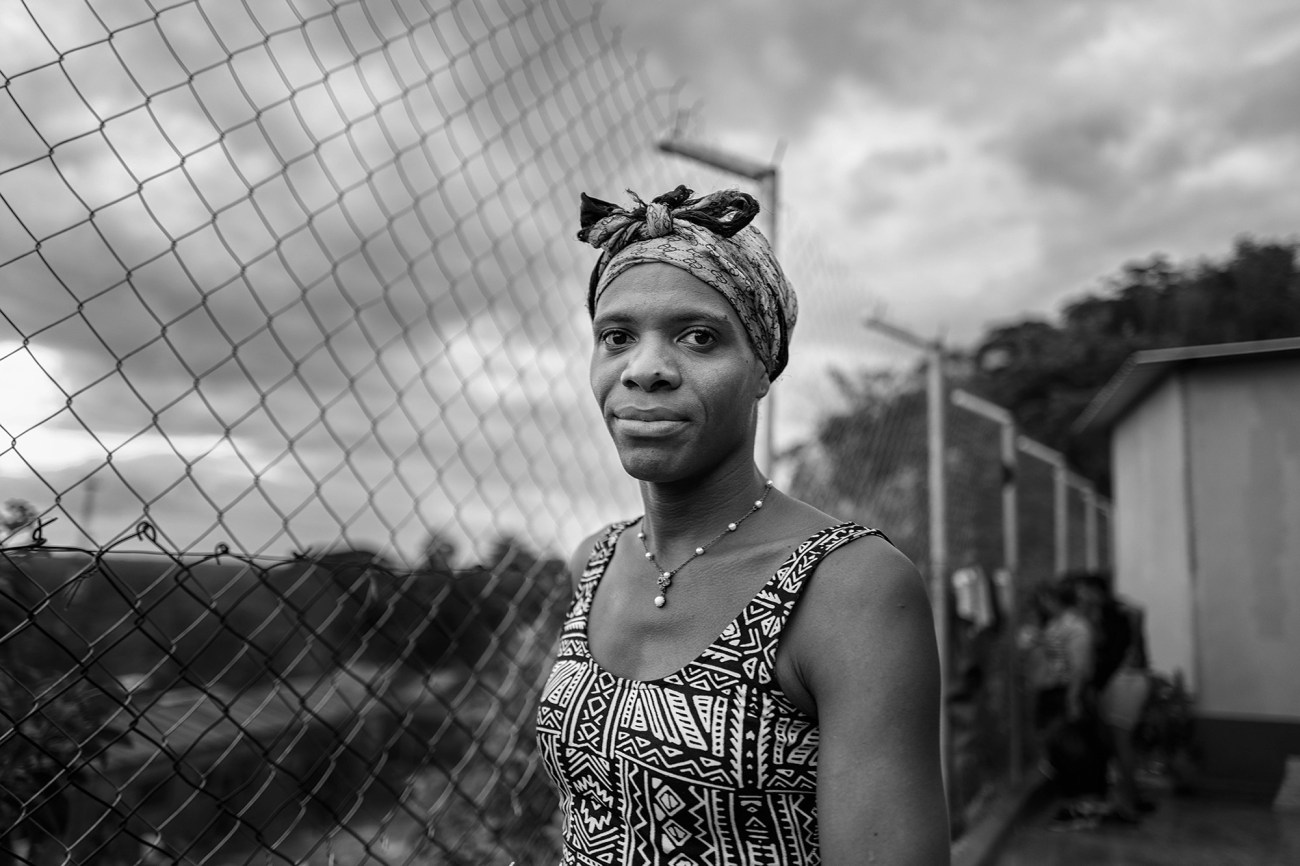
Ashley, a trans woman from Honduras, fled Honduras after her life was threatened.
In May of that year, an ocean liner named the St. Louis left Hamburg en route to Havana. On board were more than 900 German Jews with Cuban visas, many of whom hoped to head on to the United States. When the Cuban government ordered the ship to leave its waters, it headed to the eastern coast of Florida, followed by a Coast Guard patrol boat. The captain cabled authorities in the United States and Canada for permission to land, to no avail. The St. Louis headed back across the Atlantic with what the New York Times called “her cargo of despair.” (A year later, Roosevelt would tell the press, “Now, of course, the refugee has got to be checked out because, unfortunately, among the refugees there are some spies.”) In the end, the governments of Great Britain, France, Belgium, and the Netherlands agreed to take the passengers in. Roughly a quarter of them would eventually die in concentration camps.
The shame of the St. Louis was the result of the weakness of international agreements on refugees before the war. After the war, several countries, including the United States, signed on to the 1948 Universal Declaration of Human Rights—which includes “the right to seek and to enjoy in other countries asylum from persecution”—only after making sure it would not compel them to admit asylum seekers. Several years later, the foundational legal document of asylum law, the 1951 Refugee Convention, was ratified by 145 countries. Its main principle is non-refoulement, the idea that no state shall force back (in French, refouler) a refugee to a place where he has a well-founded fear that his “life or freedom would be threatened on account of his race, religion, nationality, membership of a particular social group, or political opinion.” The United States didn’t sign on to the 1951 Convention, which applied only to Europeans displaced by World War II, but it did ultimately ratify the 1967 UN Protocol on refugees, an updated version that applied to the rest of the world.
Despite these agreements, US refugee and asylum policies were often driven by Cold War political calculations meant to spotlight the plight of people fleeing communism. In the 1950s, more than 30,000 Hungarians came this way; in the 1960s and early 1970s, roughly 250,000 Cubans; and in the mid- to late ’70s, about 300,000 Vietnamese and Cambodians. These refugees were prescreened abroad; few people showed up at the border asking for help.
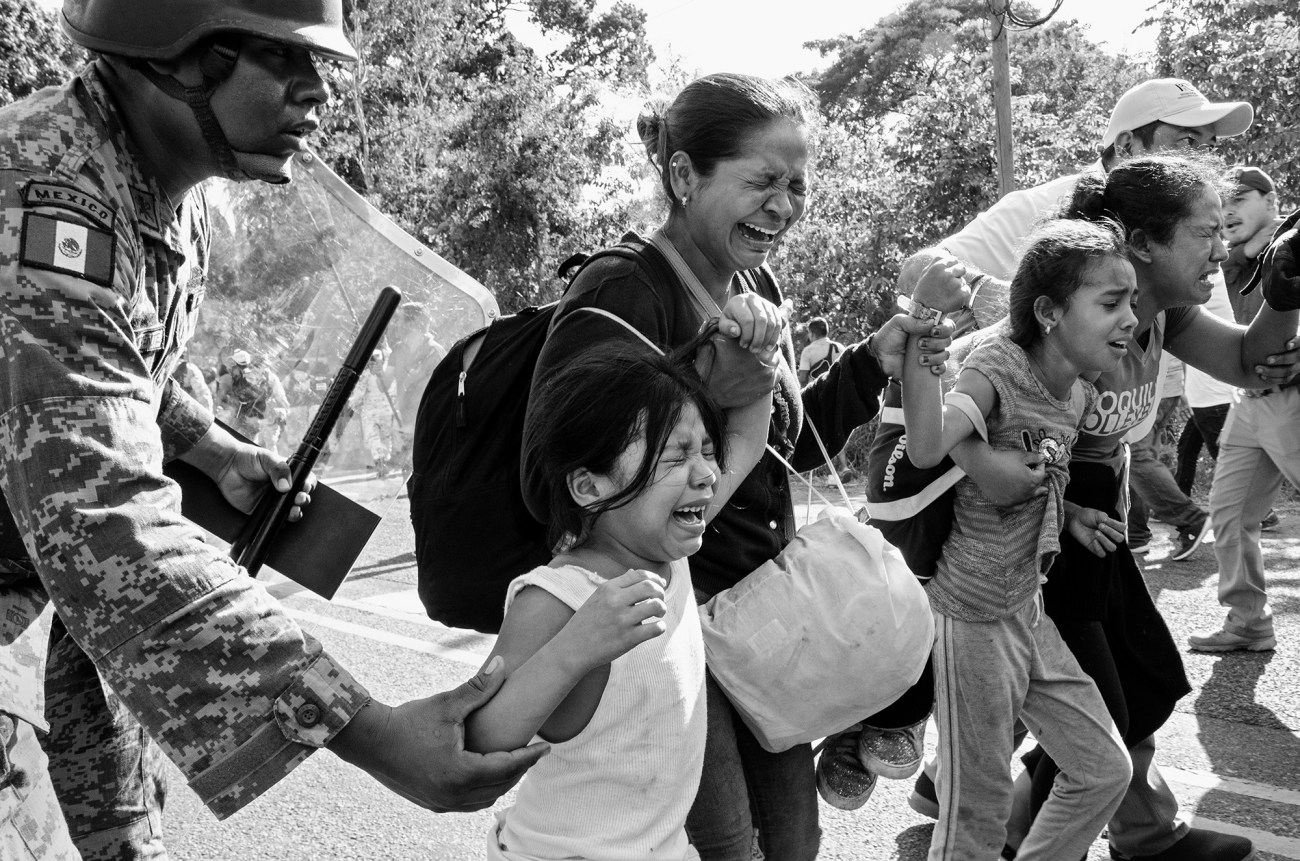
Upon arriving at the Mexican-Guatemalan border, roughly 800 migrants crossed into Mexican soil. After they walked several miles, hundreds of troops descended upon the caravan and herded many onto buses with tear gas and riot shields.
In November 1970, though, a Coast Guard cutter pulled up alongside a Russian trawler in US waters near Martha’s Vineyard. A Lithuanian radio operator named Simas Kudirka jumped onto the cutter’s deck and asked for asylum—but was dragged back onto his ship while the guardsmen watched. Back in Moscow, Kudirka was sentenced to 10 years of hard labor for high treason. His saga, however, improbably ended up as a political win for Washington. After Lithuanian Americans discovered that Kudirka’s mother had been born in Brooklyn, the Soviets let him emigrate in 1974. “I come to US not for stomach,” he told People. “I come for liberty.”
As sociologist David FitzGerald writes in Refuge Beyond Reach, “The asylum system in the West was designed primarily to embarrass communist countries whose citizens defected in relatively small numbers.” The more chances to play the freedom-loving foil to the Soviets and their satellites—and get a look behind the Iron Curtain—the better.
The limits of this realpolitik were exposed as the number of asylum seekers fleeing US-aligned regimes spiked in the 1980s. In March 1980, President Jimmy Carter signed the Refugee Act, which enshrined in US law something akin to the UN’s definition of a refugee, created a right to petition for asylum, and applied the idea of non-refoulement to asylum seekers in the United States and at its borders. A month after the law was enacted, 125,000 Cubans arrived in South Florida as part of the Mariel boatlift. About 25,000 Haitians soon followed. While the Carter administration gave relief to most of these asylum seekers, the Reagan White House would soon take a different tack, laying bare all the ways that the United States wasn’t up to the task of protecting some of the hemisphere’s most imperiled people.
One of the first things the Guatemalan military did when it came to Xoloché in 1981, Francisco told me, was to cut down and burn the corn right before the yearly harvest. It was an ominous preview of what was to come: The government’s fight against leftist insurgents had dragged on for more than two decades, but it was entering a new era of extreme violence—and the Ixil Maya of the western highlands were the targets of the military’s most vicious extermination campaign yet.
On May 3, 1982, six weeks after Ríos Montt grabbed hold of the presidency, the military entered the Xoloché area and began killing indiscriminately. Dozens of men, women, and children were tied to trees and left to die of exposure; burned alive in the fields; and shot dead. Francisco, who was 6 years old at the time, managed to escape into the mountains with his parents and his 3-year-old sister. They traveled for three weeks to a community where about 300 Ixil Maya were hiding from the military in desperate conditions.
In September 1982, the Guatemalan army caught up to them, accused them of being guerrillas, and started shooting. “I saw many men, women, and children murdered that day by the military,” Francisco later wrote in a sworn affidavit. He never saw his father again. When the shooting stopped, the soldiers took the survivors to a nearby military base before separating the mothers from their children. Francisco and his sister were among 60 kids who were told they were alone, and if they wanted a parent, they’d need to find someone in the military to adopt them. The kids who agreed to adoption were dressed up in uniforms.
What happened to Francisco’s village and family was no aberration: More than 600 massacres took place during the civil war, half of them in Francisco’s home province. Around 200,000 people were murdered or disappeared, the vast majority of them Mayan. One in seven Ixil Maya were killed.
As many as 1.5 million of Guatemala’s 8 million people were displaced between 1981 and 1983; 150,000 ended up as refugees in Mexico. In Paradise in Ashes, anthropologist Beatriz Manz cites a 1982 State Department memo that noted the refugees “expressed strong anti-government sentiments and claimed to be fleeing the army.” However, the State Department reported to Congress that “in the majority of cases” of violence with known perpetrators, the insurgents—not the US-sponsored Guatemalan army—were to blame for the attacks on indigenous Guatemalans. This was a hugely consequential obfuscation, one that dovetailed with President Reagan’s assertion that Ríos Montt was “getting a bum rap on human rights.”
In neighboring El Salvador, where Reagan was also helping arm and train the military against leftist rebels, the situation was equally dire. Outspoken archbishop Óscar Romero was assassinated in March 1980; four American nuns were raped and murdered by members of the Salvadoran National Guard later that year; and the El Mozote massacre, in which at least 700 civilians were slaughtered by the military, took place in December 1981. By the spring of 1981, the UN High Commissioner for Refugees had declared that all Salvadorans who fled should be considered refugees.
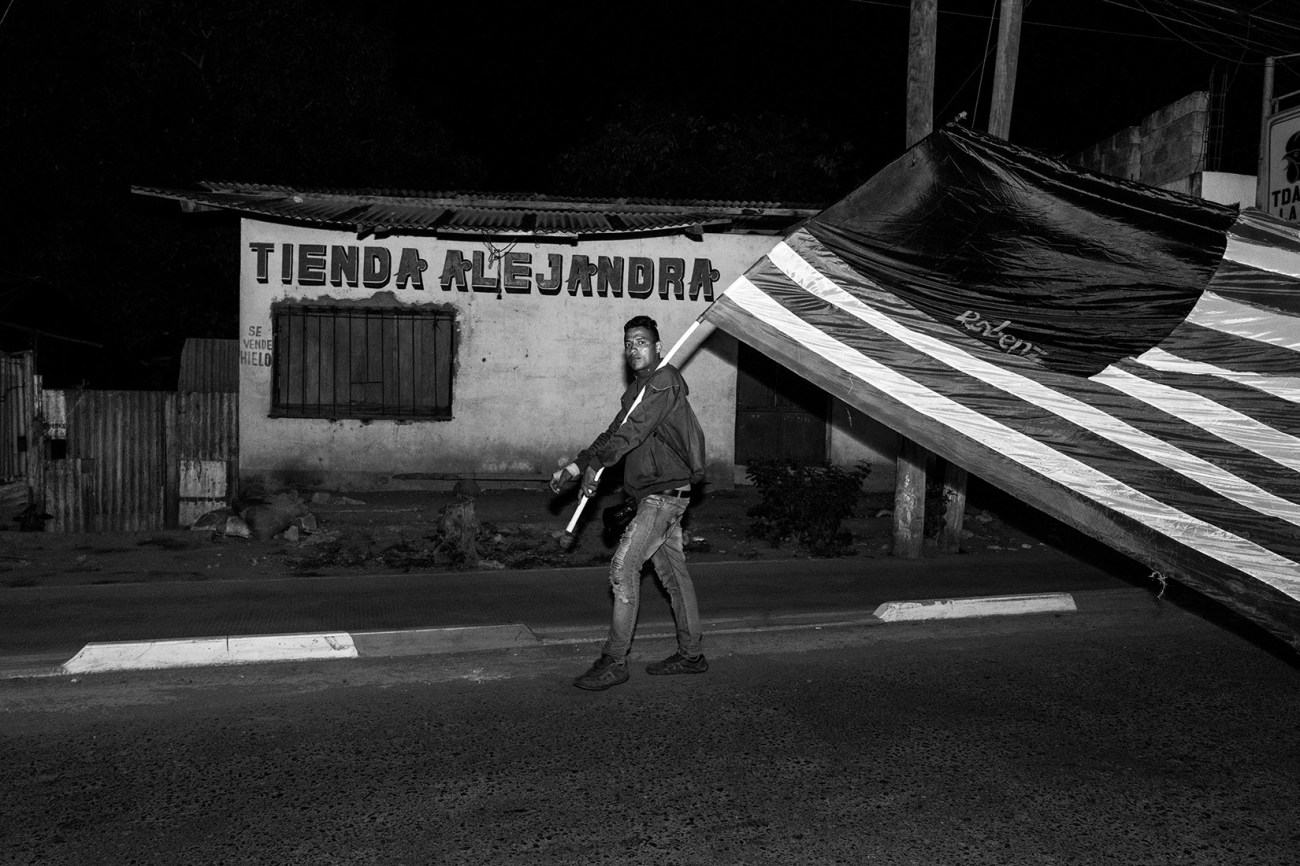
A man carries an American flag as his caravan heads north.
That message mattered little to the Reagan administration. An October 1981 UNHCR investigation found that the United States had carried out a “systematic practice” of deporting Salvadorans, regardless of their declarations of fear. Of the 6,000 Salvadorans picked up by the Border Patrol in one year, just one was granted asylum. In 1984, 98 percent of the more than 13,000 Salvadorans seeking asylum were rejected, despite the fact that many of them had presented classic claims of persecution. Because Congress had banned foreign assistance to countries that violated human rights, the administration had little incentive to lend credence to these claims. And in a since-abandoned practice, the State Department sent “opinion letters” to immigration judges, often urging them to reject individual asylum claims. The Reagan administration repeatedly waved off Salvadorans’ pleas for asylum, calling them “economic migrants” who were fleeing food shortages and unemployment. After the Immigration and Naturalization Service chief in Tucson told a reporter that the majority of Salvadoran asylum cases aren’t “so clear-cut,” he added, “Sure, El Salvador is a crummy place to live. But so is the Bronx.”
Countless Central Americans were stopped from asking for asylum in the first place. Many picked up near the US-Mexico border were taken to overcrowded detention centers and urged to “voluntarily return” to their countries. The Carter administration’s deputy assistant secretary of state for human rights told the New York Times, “You’ll get an overzealous border guard who says, ‘You either go back or we’ll lock you away for the rest of your life.’ So the poor fellow elects to go back.” In his book Other People’s Blood, Robert S. Kahn tells the unfathomable story of a Salvadoran woman who “had seen her daughter raped by Salvadoran soldiers after they forced her to execute her husband. To prevent her from applying for asylum, US immigration agents pushed Valium down her throat, then guided her hand to force her signature on form I-274, waiving her right to seek asylum.” When an immigration judge heard this story in his courtroom, he ordered immigration agents to bring the woman back from El Salvador to testify, and then put her in protective custody.
From June 1983 to September 1986, just 2.6 percent of Salvadorans and 0.9 percent of Guatemalans who arrived at the border were granted asylum. Nicaraguans running from the Sandinistas fared slightly better at 14 percent. Meanwhile, 60 percent of Iranians, 51 percent of Romanians, and 34 percent of Poles received refuge. To benefit from America’s promise to the persecuted, it wasn’t enough to be running for your life. It mattered whom you were running from—and where they got their weapons.
After six months at the military base, Francisco and his sister ended up in a Catholic orphanage. They stayed there for six of the most stable years of their young lives. Then one day a woman at the orphanage asked if they remembered their mother’s name or what she looked like. They didn’t. Their mother, it turned out, was alive. After a long and painful reacquaintance period, they agreed to reunite with her.
The family moved back to their village, even though the military had parceled out their land to soldiers. At the same time, Gaspar was growing up miles away in a community named Salquil Grande, which had been razed and rebuilt as a military-controlled “model village” with a statue of a gun-toting soldier standing at the entrance.
By the mid-1990s, the armed conflict came to an end, and a new postwar reality set in. Along with the UN-negotiated peace accords came the Historical Clarification Commission, which in two years visited approximately 2,000 communities and collected testimony from some 20,000 people, many of whom were still deeply afraid of retribution by the military. When its report finally came out, the findings—particularly that the state was responsible for 93 percent of the war’s human rights violations and acts of violence—opened wounds that had barely begun to heal.
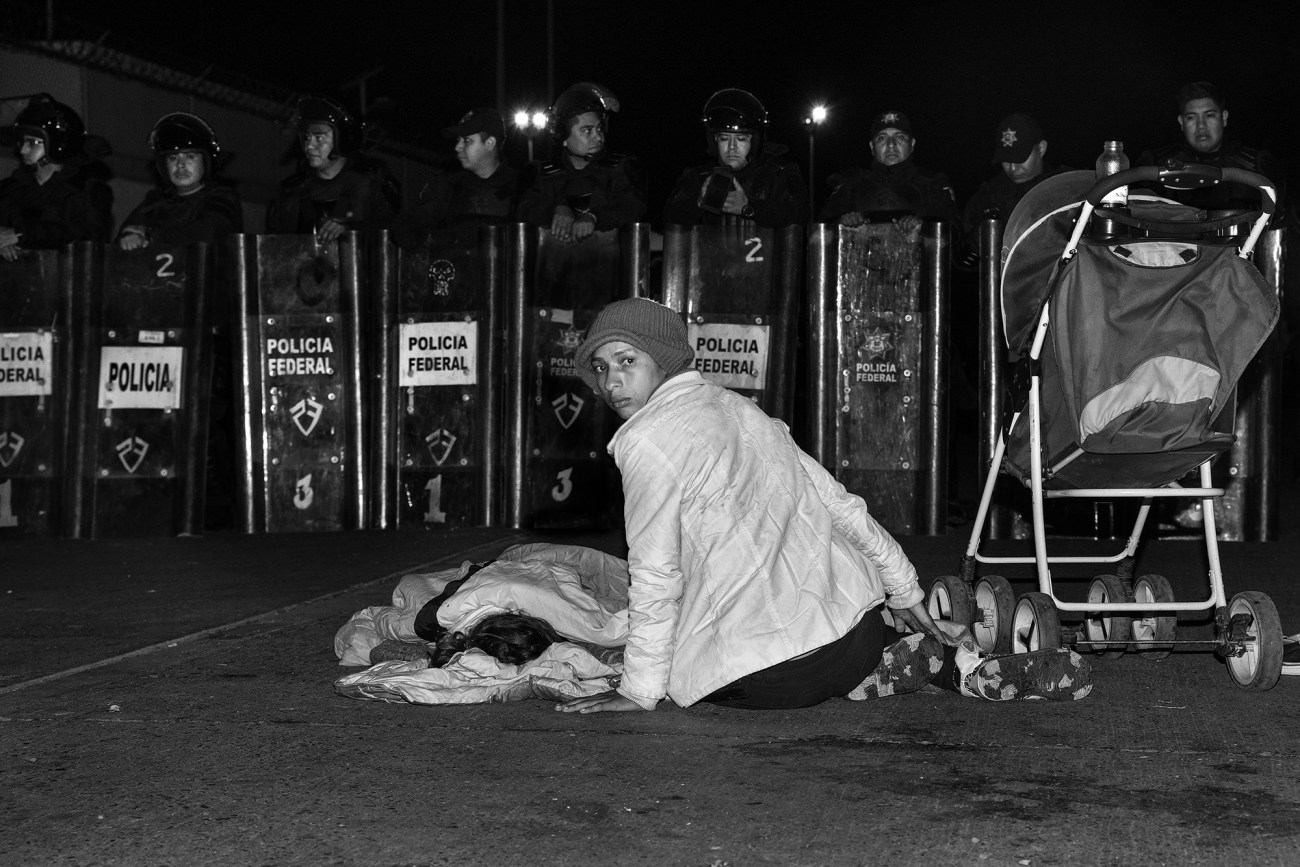
After Trump threatened to impose tariffs on Mexico, its government deployed soldiers to turn back Central American migrants. All the members of this caravan were eventually returned to Honduras.
While Gaspar became involved with environmental organizing, Francisco was working to help Ixil Maya survivors tell their stories. By the late aughts, that meant getting involved in the campaign to bring Ríos Montt to justice. After his presidential term ended, Ríos Montt had gone on to serve in Congress for almost 30 years, and, as soon as he retired in 2012 and lost the immunity that came with his office, he was charged with genocide and crimes against humanity. Francisco was one of 98 Ixil Maya who testified against the former president and the youngest of the witnesses to take the stand. “I ask that it never happen again,” he told the court. “Here I am, my feet pointing straight ahead, in struggle.”
After a number of dramatic starts and stops, the trial ended in May 2013. Ríos Montt, then 86 years old, was convicted and sentenced to 80 years in prison. The victory was short-lived. The decision was appealed immediately to Guatemala’s highest court, and in the days leading up to the final verdict, Ríos Montt’s attorney said 45,000 of the general’s supporters, former members of the civil defense patrols, would “paralyze” the country if the ruling stood. Bomb threats were called in to government offices and the Constitutional Court, which, 10 days after Ríos Montt was convicted, overturned the ruling and ordered a partial retrial. The case would continue until he died of a heart attack in 2018.
By then Central America had plunged into a newly dangerous and chaotic moment marked by corruption, gang and cartel violence, and impunity. By one 2017 estimate, 95 percent of murder cases in the region went unsolved. San Salvador, Guatemala City, and San Pedro Sula were regularly listed among the most violent cities in the world thanks to the endless turf battles between Mara Salvatrucha and the 18th Street Gang, both of which started in Los Angeles and spread south as their members were deported in the 1990s. People began to run from the Northern Triangle in the tens of thousands, and their pleas for protection—not from state violence but rather from violence the state could not or would not stop—once again exposed the limitations of our asylum system.
By 2014, US officials were referring to a new spike in asylum-seeking families and unaccompanied children from Central America as “the surge.” As the numbers skyrocketed—by the end of fiscal 2014, 70,000 unaccompanied kids and another 70,000 people traveling with family were apprehended along the US-Mexico border—Fox News and the GOP found the situation a useful cudgel to use against the Obama administration. Never mind that more than 121,000 people were deported to the Northern Triangle in 2014, 70 percent of them classified as “non-criminals,” according to historian Adam Goodman in his book The Deportation Machine. Or that a Human Rights Watch report noted that US border officials were both ignoring asylum seekers’ expressions of fear and pressuring them to abandon their asylum claims. Meanwhile, noted anti-immigrant Rep. Lou Barletta (R-Pa.) told Congress, “We know that terrorist networks have been using our porous southern border and a broken immigration system to enter the United States.” Former Rep. Duncan Hunter (R-Calif.) told Fox’s Greta Van Susteren that Border Patrol agents had told him that at least 10 ISIS combatants had been caught trying to sneak into Texas during the chaos. Then-Rep. Phil Gingrey (R-Ga.) even wrote a letter to the Centers for Disease Control and Prevention warning that some of the asylum seekers could be carrying deadly diseases, including Ebola. Of course, there was no evidence for any of these claims.
It was a moment made for Donald Trump, who wasted no time telling a conservative audience at the New Hampshire Freedom Summit in April 2014, “I would build a border fence like you have never seen before.” The next June, he announced his presidential bid after descending Trump Tower’s golden escalators, infamously saying that Mexico wasn’t “sending their best people…They’re bringing drugs. They’re bringing crime. They’re rapists.” Yet he also said something less controversial that summed up how his administration would treat Central Americans seeking asylum: “The US has become a dumping ground for everybody else’s problems.”
Trump rode his bigotry all the way to the White House, racking up supporters like Alabama Sen. Jeff Sessions and his obsessed aide, Stephen Miller, who had spent the previous years killing off comprehensive immigration reform in the Senate. Their views were shaped and amplified by anti-immigration think tanks like the Center for Immigration Studies, which, in April 2016, produced a wish list of 79 measures to restrict immigration the next president could take without Congress’ approval. It included sections on immigration benefits, illegal immigration, and, not surprisingly, asylees and refugees. It wouldn’t take long before Trump, Sessions, Miller, and campaign guru Steve Bannon put the list to use.
From the beginning of Trump’s presidency, immigration advocates found themselves back on their heels. He signed the travel ban a week after his inauguration, causing chaos as passengers on inbound flights from seven majority-Muslim countries were detained and protesters swarmed airports. Another executive order ended the so-called “catch-and-release” policy that allowed asylum seekers out of detention while their cases were pending, despite the fact that study after study found that these immigrants showed up for their hearings.
Then, in April 2018, Sessions, now attorney general, announced a “zero tolerance” policy at the border: In the past, only some migrants were charged in federal court for crossing illegally into the country, but now all would be. Two months later, he’d undo years of precedent by deciding that victims of domestic abuse or gang violence would no longer qualify for asylum. Over the next year, the number of asylum cases approved for Guatemalans, Hondurans, and Salvadorans would drop by half, to only 10 to 15 percent.
Zero tolerance paved the way for family separation, an idea that had been floated by Homeland Security Secretary John Kelly as early as March 2017. Over a year, more than 5,400 kids would be separated from their families, including 207 who were 4 years old or younger. After Sen. Merkley’s viral posts, ProPublica’s publication of an audio recording of children sobbing in detention, and an intense national backlash, family separation came to an end that summer. “I didn’t like the sight or the feeling of families being separated,” Trump croaked at the White House in June 2018.
The number of asylum seekers climbed back up but the administration’s indifference toward them hadn’t changed. “The bulk of these people are economic migrants,” a senior administration official told the New Yorker. So Trump and Miller started their push to close the border for good. “If you think of what’s happened as a war,” said Aaron Reichlin-Melnick, the policy counsel at the pro-immigrant American Immigration Council, “in the first two years of the war, the Trump administration’s attacks on asylum were largely beaten back. But in this third year—through a wide variety of new and more insidious attacks—the Trump administration largely achieved its goal of choking off most asylum at the border.”
The attacks began when the administration capped the number of asylum claims that could be made at any given border entry on any given day. By May 2018, as my colleague Noah Lanard reported, Customs and Border Protection officials were standing in the middle of the bridge connecting Matamoros, Mexico, and Brownsville, Texas, preventing asylum seekers from entering the United States. In August 2019, the Strauss Center at the University of Texas, Austin, reported that there were 26,000 people stuck in Mexican border cities waiting for permission to initiate their asylum claims.
Trump made things even worse when he tweeted at the end of 2018 that a caravan of thousands of Central American asylum seekers was “an invasion of our Country” filled with “many Gang Members and some very bad people.” Shortly after that, he implemented the Migrant Protection Protocols, also known as Remain in Mexico. “It is a program designed to deny people the right to seek asylum,” Reichlin-Melnick said, “using the facade of law to cover up what is, in effect, a deportation order machine.” It also sought to make the problem invisible to Americans: Under MPP, people who ask for asylum at the border are given court dates and quickly sent back to Mexico to wait. In MPP’s first year, border officials sent as many as 62,000 people back to dangerous Mexican border towns to await their hearings in the United States. Many of them ended up living in tent cities, with no protection from the cartels that kidnap migrants to extort family members in the United States. In late 2019, Human Rights First recorded more than 630 cases of kidnapping, torture, rape, and other attacks against asylum seekers who had been forced back to Mexico. “The whole thing is a fucking disaster designed to fail,” a lawyer told Mother Jones earlier this year.
Remain in Mexico provoked a mini-revolt among asylum officers. To avoid being turned back, asylum seekers had to tell a Border Patrol agent, without prompting, that they were afraid of returning to Mexico. Only then could they get an interview with an asylum officer, who had been ordered to apply a stricter standard while hearing claims. “Because, intentionally, so many people are passing this process, the administration got upset with that,” said Doug Stephens, a former asylum officer turned whistleblower who told his story in a Pulitzer-winning episode of This American Life. “So there’s a series of emails and memos that came down, really pushing the officers to dig into credibility issues during the interview.” Stephens tried to get out of hearing MPP cases but couldn’t—and ended up sending a Honduran man and his child back to Mexico simply because they didn’t tell him that the Mexican cops who had threatened them did so because of their nationality. Another asylum officer, racked with guilt over a particular case, told reporter Molly O’Toole that she threw up in the shower every day because “I feel in some ways that this administration has made me a human rights abuser.”
Gaspar and Francisco awoke in the middle of the night on June 8, 2019, said teary goodbyes to their wives and children, and trudged through the predawn drizzle to begin their trip north with their smuggler. It wouldn’t take long for trouble to find them.
Less than a week after they left Guatemala, the van they were traveling in was pulled over by police in northern Mexico. “You’ve got Indian faces,” they said, laughing, according to a report Gaspar and Francisco later filed. “Give me a break, you fucking Indians, you’re not from here. Tell me where you’re from.” The officers told them to hand over whatever money they had; when the police weren’t satisfied, some pickup trucks arrived. Men with guns—but no uniforms—hopped out. The driver told Gaspar and Francisco that they were with a cartel.
Eventually, the cops let them go. Upon arriving in Ciudad Juárez a day later, their coyote brought them to a warehouselike building holding hundreds of men, women, and children. There was little food, and when people complained, the men in charge said they’d be disappeared if they kept it up. Gaspar and Francisco soon escaped and made their way to the district attorney’s office to file a complaint against the state police.
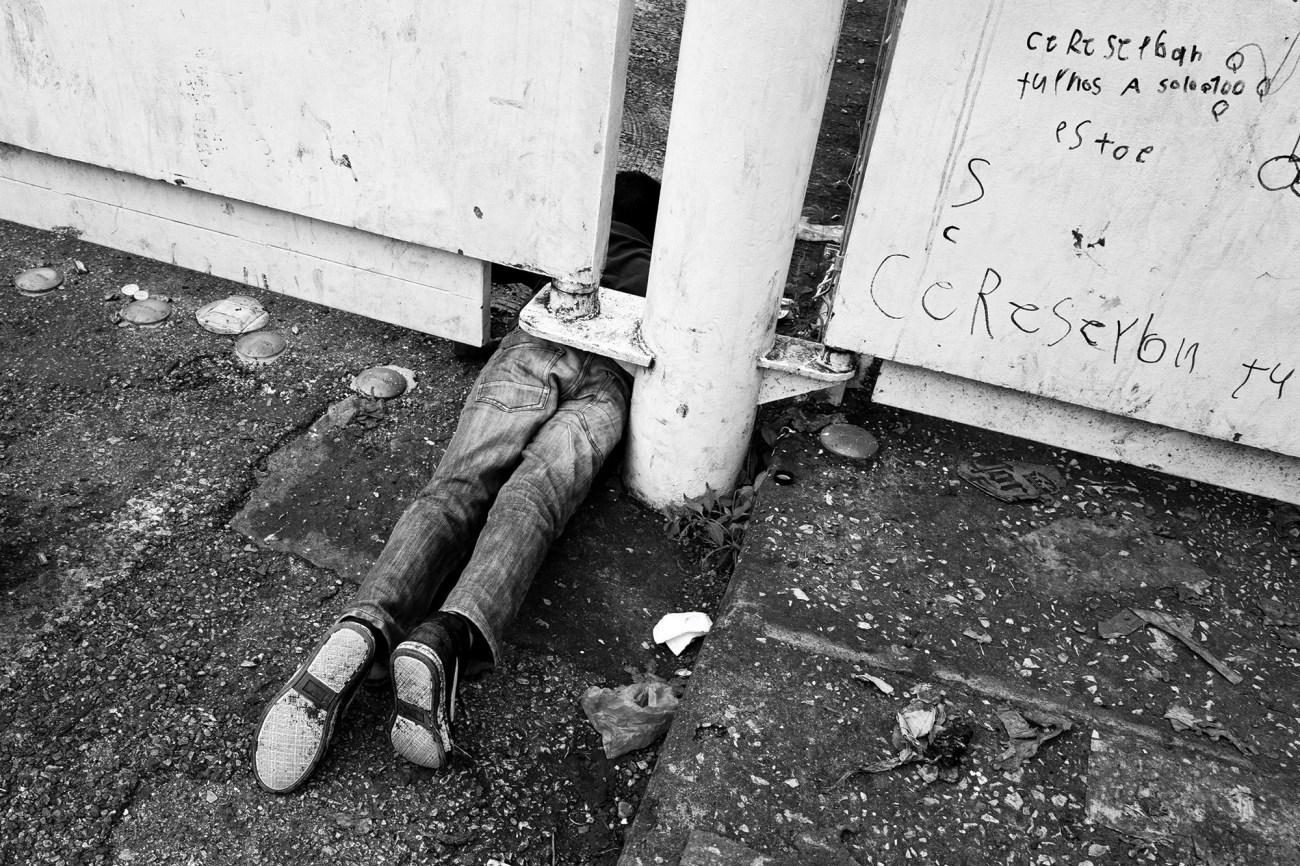
An unaccompanied minor tries to cross under a gate from Guatemala into Mexico.
The woman who greeted them said their claim was a lie, before handing them off to a man who said they were trying to manipulate the system. “Tell your lawyer to come up with a better lie,” he told them, “because this one isn’t going to work.” They then filed a complaint with the state human rights commission, asserting they had been targeted by the police because they were indigenous Guatemalans. In the meantime, they were put in touch with Spector, who helped them build a case for claiming asylum. They had done exactly what Trump’s Remain in Mexico policy required: created a paper trail establishing they had reasonable fear of staying in Mexico because of potential retribution by the state.
A couple of weeks later, Spector met Gaspar and Francisco on the Juárez side of the bridge to escort them across at dusk. They carried with them a fat folder full of their documents, including the human rights complaint. As they walked toward El Paso, they met a Border Patrol official who brought them in for a meeting at the port of entry.
While they did their interviews, Spector waited. And waited. Finally, he got a phone call: They were done—and were back in Juárez, where they’d have to remain until their date in immigration court. Their cases didn’t meet the impossible threshold set by Remain in Mexico; their stories had fallen on the willfully deaf ears of an agency, and an administration, that proudly had dropped the pretense of giving a damn about people like them.
“I was shocked,” Spector admits. “It’s hard to be shocked anymore.”
Trump’s attack on asylum has only intensified. On July 16, 2019, the administration announced it was banning virtually all non-Mexicans who arrived at the southern border from applying for asylum. A more limited kind of protection is available, but unlike asylum, it can never result in a green card or citizenship. Later that year, the White House rolled out two more programs that speed up the screening process, prompting several Democratic members of Congress to complain that they “appear designed to deny asylum-seekers access to counsel while rushing vulnerable families fleeing persecution through life-or-death legal screenings behind closed doors.”
All the while, Trump was leaning on the presidents of Guatemala, El Salvador, and Honduras to sign so-called safe-third-country agreements that would allow the feds to send people back to Central America to apply for asylum there. (The US had only one such agreement in place, with Canada.) Acting Customs and Border Protection Commissioner Mark Morgan argued that the Central American agreements were crafted to protect asylum seekers, not put them in harm’s way. “It really is in their best interest to apply for asylum to the first country that they have entered outside of the country that they are being persecuted,” he said. At the time, El Salvador had one asylum officer; Guatemala had maybe a dozen. “To pretend that those countries are safe countries for asylum seekers,” said Karen Musalo, the director of the Center for Gender and Refugee Studies at the University of California, Hastings, law school, “is beyond obscene.”
News reports from Guatemala were beginning to reveal how disastrous the safe-third-country deal was when COVID-19 began to dominate everyone’s lives. Just like that, on March 20, the head of the CDC, Dr. Robert Redfield, decreed that the border would be shut to all noncitizens. For years, the Times would later report, Miller had been hoping to use the threat of a public health crisis to seal the frontier with Mexico. He finally had one, and he didn’t miss his chance: By locking out virtually all asylum seekers, the administration has kept them out of sight—so much so that news about unaccompanied children being held in hotels pending their rapid expulsion barely cut through the noise. Imagine the depths to which Trump and Miller might sink in a second term.
Gaspar and Francisco are still stuck south of the border, waiting for their next court date in El Paso. They’ve gotten jobs at a maquiladora making cardboard boxes, and in their downtime they keep in touch with their families. “My children,” Francisco texted on Father’s Day weekend, “let’s stay calm but also have hope.”
They have enlisted the help of immigrant rights activists to spread their story and have set up a GoFundMe campaign to raise money for their families. In one video update, Gaspar’s wife, parents, and three children—including his crying infant daughter—thank viewers in Ixil for supporting them. “For my three grandchildren,” Gaspar’s father says, “it’s difficult to be without their dad, but one day they’ll understand why he’s gone.”
Spector isn’t sure what would be worse for Gaspar and Francisco: being trapped in Juárez, potentially with a target on their backs, or being locked up in an immigration detention facility where the coronavirus has wreaked havoc and officers have pepper-sprayed detainees asking for better conditions. “That’s a fucking nightmare,” he told me. He’s still at a loss when it comes to their case, which he calls one of the strongest he’s had in 30 years of being an immigration attorney. “If they can’t get in,” Spector said, “nobody can.”
Right now, it doesn’t matter how detailed, how plausible, how consistent your story is. It doesn’t even matter, in a basic sense, how true it is. Asylum is dead. And the power of stories—the one asylum seekers like Gaspar and Francisco tell to save themselves, the one the US government tells about the fairness of our laws, the one we tell ourselves about our goodness, our decency as Americans—died with it.
